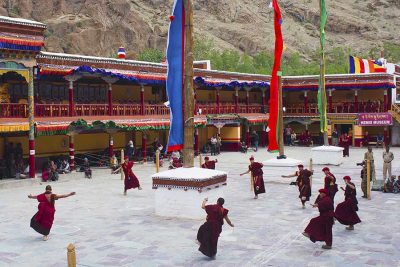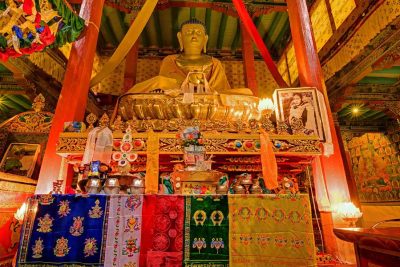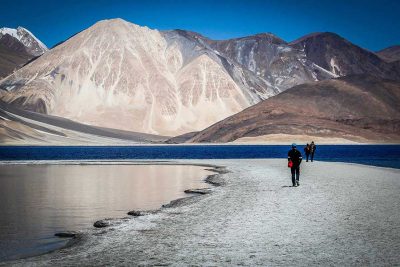Meditation, monastic experience and community trekking in Ladakh
13 Days
ABOUT THE ITINERARY
Tired of the hustle and bustle of your daily life? Do you really need to experience a life time adventure in an extraordinary Himalayan landscape far away from the ordinary world? If so, maybe this itinerary is done for you! Perched at an altitude of over 3,500 meters, Ladakh is an isolated plateau fringed with soaring snow-capped mountains and enormous sweeping valleys, and deep turquoise lakes dot this high-altitude desert. This raw and awe-inspiring ancient land is often referred to as Little Tibet and is home to one of the best-preserved Tantric Buddhist societies in existence. This itinerary is designed to experience the essence of Buddhist spirituality in India. Ladakh region Indian Himalaya has been a spiritual land for centuries. This tour is not for everyone, but only for experienced traveller who wants to go deep into the culture and practices of Tibetan Buddhism. Ladakh — once the hub of the ancient Silk Route — is aptly described as a place where Buddhist spirituality and its ancient culture reign supreme amidst virgin nature. It’s a cold desert in northern India, dotted by tiny hamlets spread over the Himalayan peaks adjoining Tibet, where one can simultaneously have a close brush with sunburn and frostbite in summer.
To experience Himalayan Tibetan Buddhist Spiritual atmosphere and to take part in daily activities, Conscious Journeys has designed this experiential tour to Ladakh for spiritual seekers or curious travellers who wants to discover this ancient land not only from a touristic point of view. There are many tours to Ladakh, but this one is different from others. You will be willing to practice meditation in one of the most traditional centres in Ladakh and take part in a soft trekking, living in local homestays led by a women Organisation. As soon as you reach Leh, you will have the chance to take part in a two days meditation retreat. We have selected an incredibly beautiful Retreat Centre, an inspiring oasis of tranquil contemplation, located in a secluded corner, dominated by Rocky Mountains on one side and golden sand dunes on the other. The sweet scent of fragrant and jewel-like flowers, which line the footpaths of the centre, play joyfully on the senses, while enigmatic stupas, reclusive meditation caves, abundant prayer flags, and the most sacred and eye-catching Milarepa rock cave provide silent spiritual encouragement. This experience will help you in the process of acclimatization at 3500 metres altitude.
Conscious Journeys offers you a unique opportunity to stay with and share the culture of the Ladakhi people in remote villages, while trekking through the rugged habitat of the endangered snow leopard. Its authentic interactions with Ladakhi people and exploration into the core of Ladakhi culture provides a perfect opportunity that you will never forget in life. During this tour you will discover all the major monastery of the area. In Lamayuru you will meet a small community of yogis, who practice a kind of tantric meditation that was practiced in ancient Tibet by great yogis like Milarepa, Naropa. Here you will have a chance attend the Chod ritual, a very ancient tantric practice. It truly is an enchanting place; one rarely feels so close to nature amidst the unforgettable scenery. With this special itinerary, you will have the rare opportunity to spend a day with the local tribe of Aryans in Dah and Hanu villages, to know more about their culture and activities (mostly farming and agriculture). This unique experience will allow you to discover a different side of Ladakh, out of the beaten path – in fact to visit Dah and Hanu village a permission is required.
SIGN UP FOR THE TRIP
Registration can be requested for group travel or for self-travel. For group travel, registration is not binding. Upon reaching the minimum number of members necessary for the formation of the group, usually 4 or 6 people, you will be asked for confirmation of booking and payment of a deposit.
JOURNEY OVERVIEW AND PROGRAM DETAILS
1° Day: arrival at Delhi
Arrival at Delhi airport. Transfer to hotel for some rest. Some of the most famous attractions are the Qutub Minar, the Red Fort, the Mughal Gardens, the Akshardham Temple, Lotus Temple, Raj Ghat etc. After some rest you will visit the Jama Masjid, the mainthe main mosque in Old Delhi (every day nearly 25,000 people visit and pray inside this mosque). An ancient copy of the holy Quran is also preserved here, which was written on Deer skin. Visit small lanes of this part of the city such as Chawri Bazar, one of the busiest street of Old Delhi. After you will visit the Red Fort, known as LalQila or Qil’ah” was constructed by the Mughal Emperor Shah Jahan. The fort was originally the palace of the Mughal emperor, after the capital was moved from Agra to Delhi. Delhi was the capital of the Mughals until the revolt of 1857. Overnight in Delhi.
2° Day: fly to Leh
After an early breakfast, you are transferred to the domestic airport for your flight to Leh. This must be one of the most sensational flights in the world. On a clear day from one side of the aircraft can be seen in the distance the peaks of K2, Nanga Parbat, Gasherbrum and on the other side of the aircraft, so close that you feel you could reach out and touch it, is the Nun Kun massif. Upon arrival, you will be transferred to your hotel. You would take a little time to settle in and acclimatize since you have gone from a relatively low elevation in New Delhi to over 3.500 metres! You will spend the day acclimatizing and enjoying the beautiful landscapes.
Overnight in Leh (B,L,D)
3° Day: meditation retreat Choglamsar
After breakfast transfer to Choglamsar about 10 km from Leh for 2 nights meditation retreat. On the outskirts of Leh resides a large Tibetan refugee community in the village of Choglamsar, an idea that sprang from concerns of XIV Dalai Lama for the Tibetan Settlement in Ladakh. Devachan meditation camp is dominated by Rocky Mountains on one side and golden sand dunes on the other. The place with its enigmatic stupas, reclusive meditation kuties, abundant prayer flags, and the most sacred and eye-catching Milarepa rock cave provide an ideal occasion for spiritual engagement. These 2 days meditation courses will be conducted by Bhikkhu Sanghasena, founder and spiritual Director of Meditation Centre and the course will be based on the essence of the Buddha’s teachings. This retreat will be useful to acclimatize with the altitude and to have a direct experience of spiritual practices of Buddhism.
Overnight at Mahabodhi Society (B,L,D)
4° Day: meditation retreat Choglamsar
After breakfast transfer to Choglamsar about 10 km from Leh for 2 nights meditation retreat. On the outskirts of Leh resides a large Tibetan refugee community in the village of Choglamsar, an idea that sprang from concerns of XIV Dalai Lama for the Tibetan Settlement in Ladakh. Devachan meditation camp is dominated by Rocky Mountains on one side and golden sand dunes on the other. The place with its enigmatic stupas, reclusive meditation kuties, abundant prayer flags, and the most sacred and eye-catching Milarepa rock cave provide an ideal occasion for spiritual engagement. These 2 days meditation courses will be conducted by Bhikkhu Sanghasena, founder and spiritual Director of Meditation Centre and the course will be based on the essence of the Buddha’s teachings. This retreat will be useful to acclimatize with the altitude and to have a direct experience of spiritual practices of Buddhism.
Overnight at Mahabodhi Society (B,L,D)
5° Day: visit the palace Leh
After the 3-day meditation retreat, you will be ready to discover with more awareness the essence of Ladakh, a true paradise for trekkers, with many beautiful trekking routes, picturesque valleys and lakes. This place is also known as “the land of monks and of monasteries”. After breakfast, visit the TCV school, an integrated charitable organisation, which aims to ensure that all Tibetan children under its care receive a good education, a strong cultural identity and become self-sufficient and active members of the Tibetan community and the world. This is the only Tibetan school in Ladakh. Later transfer to Leh. Exploring the fascinating labyrinth of winding streets and picturesque local bazaars. The main street is open and airy, with rows of shops on both sides. Visit the spectacular Royal Palace of Leh, an amazing historical building that dominates the city; built in the 16th century, more or less in the same period as the Potala Palace in Lhasa (Tibet), which in fact has similar features. In the evening, walk to the Shanti Stupa to admire a beautiful sunset.
Overnight in Leh (B)
6° Day: monastery exploration Hemis
After breakfast, visit Thiksey and Hemis monasteries for morning prayer. Thikshey Monastery, perched on a rocky hill, resembles the Potala Palace in the Tibetan capital of Lhasa, famous for its distinctive architecture and location. Located on the top of a hill in the Indus Valley, the 12-floors monastery has 10 temples, assembly hall, rare and precious stupas, statues, thangkas, wall paintings and swords. It housed a large statue of Maitreya Buddha, whose purity of gaze invites reflection and silent meditation. Here you will participate in the morning prayer. Later, visit the Hemis monastery, the most famous and largest in Ladakh, belonging to the Drukpa order of Tibetan Buddhism. During the festival of the same name, which takes place every year in the monastery, you can witness at the Cham dance known as dance of the mystical mask. The monks wear flowing brocade costumes and brightly painted papier-mâché masks, depicting demons, and perform the chams or masked dance, representing the victory of good over evil. On the way back to Leh visit the Stok palace which houses a beautiful private museum. It will be a superb collection of thangkhas, which is said to be the best in the world.
Overnight in Leh. (B, D)
7° DAY: TREKKING YANGTHANG
After breakfast, transfer by car to the Sham valley for 3 days of trekking (possibility of leaving your bags at the hotel in Leh and preparing a small backpack for just the 1 day of trekking. The suitcase will be taken at the end of the trek to Lamayuru). Start with the first the trekking route of approximately 3 hours, the perfect way to explore the cultural and natural heritages of the Sham. This is a responsible tourism initiative in collaboration with a group of women who will act as guides and host us in their Homestays during the route. The itinerary is easy to follow, because the aim is not to reach the highest peak, but to walk and to travel consciously and slowly, to savor the essence of this journey. You will cross the Pobe La pass (3550 m), then descend to Sumdo (3470 m), a small village of 2 families located in a small river valley. Time to rest under the shady trees, before climbing back up to the Charatse La pass (3650 m).
Overnight in Yangthan (B, L, D)
8° Day: trekking Hemis Shupachan
After breakfast in your homestays start another day of easy trekking (approximately 3 hours) towards Hemis Shukpachu (3690m). You will cross Sarmanchan La pass (3750m) and descend to the large, prosperous village of Hemis Shukpachu. The village has a grove of juniper trees. There are not too many juniper trees in Ladakh and hence, Hemis-shukpachan is famous for having a grove of them! The trees, held sacred by the local people, are protected by the Forest Department. Time to explore the village with your host family. Overnight in Hemis Shupachan (B,L,D)
9° Day: TRANSFER TO LAMAYURU
After breakfast start your trekking (around 4/5 hours) towards to Temisgang (3200m). You will have a gradual walk up to Mebtak La pass (3820m), then short steep down. Enjoy mountain views as you walk towards the steep zig-zag path up to Lago La pass (3820m). Keep watching for Ladakh Urial. As you reach Temisgang visit the monastery and palace. Later, drive to Lamayuru. Our journey weaves through remote mountain passes and deep river valleys that embed themselves eternally in your heart and mind.
Overnight in Lamayuru (B, L, D)
10° Day: VISIT TO DAH AND HANU VILLAGES
After breakfast, visit the monastery. Dating back to the 11th century, it is not only the oldest and most picturesque, but is said to have been the first place of learning in Ladakh of the Drikung Kagyu tradition of Tibetan Buddhism. Visit to the meditation centre of Lamayuru, which hosts a small community of yogis, who still practice a sort of tantric meditation from ancient Tibet, already practiced by great yogis such as Milarepa, Naropa. You will meet the Yogis, interact with them and witness the Chod prayer ritual. The Chod ritual is an esoteric tantric practice that aims at separation from the ego and attachment to the body, mentally visualizing offering one’s “material” part to all sentient beings, especially to the restless, hungry creatures of the spirit world. To follow, typical local lunch at the meditation centre. After lunch, transfer to the villages of Dah and Hanu (2 hours approximately). These villages are well known for its local tribe of Aryans. This cultural group is said to be the last of the Aryans to be confined to the valley. They have preserved their racial purity over the generations and their origins are pure Indo-Aryan. The main field of employment here is farming and agriculture. They raise enormous numbers of goats, along with cows, lambs, and yaks as livestock in addition to cultivating apricots. Wheat produced from yak milk is a staple food of the Aryan people. The younger generation has relocated to larger towns in quest of better jobs and education while the older generation continues to live in this community. Although modernization has not diminished their pride in their ancestry. One can still clearly see that in them even today in their appearance, actions, and even their friendly hospitality. Here you will have the opportunity to spend a day with Aryan tribe and learn more about their culture and activities, and enjoy a traditional tribal cuisine.
Overnight in homestay in the village (B, L, D)
11° Day: TRANSFER TO ULEYTOKPO
In the morning spend some time in the village with your host family, free time to stroll and to interact with locals enjoying their special hospitality. Traditional lunch with the community with local products. After lunch overland transfer to Uleytokpo (around 3 hrs). Check in a tented camp and enjoy the location. This is a special opportunity to live an extraordinary experience in a tent camp, surrounded by breathtaking landscapes of the Himalayan region between wide valleys, impressive mountain peaks and lunar landscapes. Free time to explore the surroundings, before your stay overnight in the tented camp.
Overnight in Uleytokpo (B, L, D)
12° Day: VISIT ALCHI AND LIKIR MONASTRIES
In the morning visit Rizong monastry. Situated at the top of a rocky side valley on the north side of the Indus, to the west of Alchi on the way to Lamayuru. It was established in 1831 by Lama Tsultim Nima under the Gelukpa order, at Ri-rdzong. There are 40 monks in the monastery. The monastery is also called “the paradise for meditation” and is noted for its extremely strict rules and standards. After the visit, transfer for lunch at Alchi kitchen, to enjoy Ladakh’s traditional cuisine. Later visit the Alchi monastery. Founded in the 11th century by Rinchen Zangpo, the Great Translator, it was richly decorated by Kashmiri and Tibetan artists. This monastery is famous for its magnificent, very well-preserved wall paintings, dating back to the 11th or 12th century. The monastery is run by Likir monks and is no longer active as a place of worship. Last visit will be Likir Monastery, built in the 11th century and known for a 75 m high Buddha statue. The Likir monastery is one of the oldest monasteries in Ladakh and has many stories of its existence and origin. It offers panoramic views of the surreal landscape and the snowcapped Himalayan mountains. The natural beauty of the nearby surroundings attracts numerous visitors across the globe. While visiting this monastery, make sure that you also visit the small villages near the gompa as they offer amazing views for flawless photography. After the visit, transfer to Leh (around 1 hr) for overnight.
Overnight in Leh (B, L)
13° Day: depart from Leh airport
After breakfast, transfer to Leh airport and depart for your international flight via Delhi.
ACTIVITIES
- explore Delhi with its ancient neighbourhoods and modern buildings,
- practice meditation during 2 days residential retreat,
- visit the Tibetan refugee community in the village of Choglamsar,
- choose your favourite cave where to practice meditation,
- discover an integrated development project of Devachan,
- explore fascinating labyrinth of winding streets in Leh,
- visit the spectacular eight-storey of Leh Palace,
- admire a beautiful sunset from Shanti stupa,
- learn the activities and mission of the Women’s Alliance of Ladakh,
- experience a morning prayer with monks in Thikshey Monastery,
- visit the most famous and largest monastery of Ladakh, Hemis,
- experience three days easy trekking in the Sham Valley
- take the chance to interact with your host family during the trekking,
- meet and interact with Yogis and attend the Chod prayer lead by Yogis in the meditation centre of Lamayuru,
- Spend one day in Dah and Hanu villages and meet with the local community of the Aryans
- Spend a night in a tented camp while you are enjoying a breathtaking Himalayan landscape
- Enjoy a demonstration cooking class in the famous Alchi Kitchen
- discover Alchi, Rizong and Likir Monastery
SOCIAL AND ENVIRONMENTAL IMPACT
All the itinerary has been designed in order to promote direct or indirect benefits for local communities, environment and cultural heritages. When possible, we have selected traditional accommodations sensible to social and environmental issues, following general principles and practices of responsible tourism. The tour is designed to include the activities of various local communities, through the use of a number of local homestays, which get economic support from the trip. Recently homestays have been started in villages in some of the trekking areas, generating income for the villagers and reducing the strain on the ecosystem caused by camping. On most of the trekking routes in Hemis National Park, trekkers can now use homestays as they trek from village to village. During our soft trekking from Likir to Hemis shupchan you will have a change to spend two nights in traditional homes where you can eat Ladakhi food, meet local people and experience the Ladakhi culture and lifestyle. The homestay system was started by the Snow Leopard Conservancy, a non-government organization, dedicated to preserving Ladakhi wildlife. The system was set up in order to generate income for the villagers in Hemis National Park, famous for its wildlife. In the past snow leopards used to kill many of the domestic animals, and since the people were dependent on the domestic animals, they tried to kill the snow leopard to preserve their livestock. The villagers were trained in flora and fauna, how to maintain a tourist friendly home and taught how to prepare food hygienically. 10% of the income goes to local development. In Choglamsar village during the 2 days meditation retreat you will visit a kind children’s school village. Set up in 1975, it is a thriving village with its own school, facilities and centres that offer training in handicrafts and other such vocations. The premises also flaunt an agro-nomadic farm and an old people’s home. Often called an ‘oasis in the desert’, it serves both the Tibetan and Ladakhi communities and is a beautiful example of ethics of care and universal responsibility for all. A dedicated team of social workers, teachers, doctors, monks, nuns, community leaders and care-providers have created an integrated community at Devachan in Ladakh which provides comprehensive care to all segments of society: children, elderly, special needs individuals, monks & nuns, the sick, as well as those seeking spiritual development. The community has become a model for the region through sustainable, ecological development. This trip to Ladakh redefines the conventional form of travel and gives an ingenuous essence to the spirit of traveling with a difference. From definitely being one of the most memorable trips of a lifetime to being a carbon positive trip to creating additional livelihoods and revenues for the local communities, this is a journey that merges conservation and travel. What if your travels could also generate a positive karmic footprint?
TIPS BEFORE DEPARTURES
A conscious approach to travel requires a considerable capacity and willingness to adapt and adjust to the local environment and culture. If you wish to travel with us we request you to be open enough to experience local culture, religious and traditions without bias and pre-conceived ideas you might have before the departure and which belong to our Western cultural way of thinking. Exploring with fresh eyes, with patience and openness, you will be able to access the real essence of the cultural heritages and spirituality through the places and people you are going to meet; if you are ready to do this effort you will really enjoy the beauty of the rich culture and religiousness of Ladakh, the extraordinary of the nature, the solemnity of Buddhist monasteries.
As a foreign visitor to Ladakh we request you to respect the rights and beliefs of local people and to minimize your impact, both culturally and environmentally. Be aware of your actions and how they will affect the people and environment around you. Here are just a few suggestions of things you may like to consider while visiting Ladakh:
- Dress appropriately – “more is better”, revealing clothing is not suitable, especially for women, but men should also not go shirtless. T-shirts and trousers/long skirt are the recommended dress. Sleeveless and/or low-cut tops, and shorts are not suitable for either men or women – always cover your shoulders and legs. Demonstrating an effort to be sensitive to their culture will enhance your experience with the Ladakhi people. You will also avoid sunburn if you cover up!
- Please don’t encourage begging – don’t hand pens, money or sweets directly to the children. This not only encourages begging, but also causes conflict between the children themselves. One of the many organizations in Ladakh set up to help children could put your kind donation to better use. Every school in the rural areas would gladly accept your gift of pens and distribute them amongst the children.
- Leave nothing but footprints…. Let’s help to keep unnecessary rubbish from accumulating in these magnificent mountains. Avoid buying anything in plastic bottles as there is no recycling available and plastic is often burned, polluting the environment further – instead fill up your own water bottle with boiled, filtered or treated water.
- Smile… easy to give, wonderful to receive. A smile surpasses all cultural boundaries.
This itinerary offers good opportunities for cultural exchange, adventure, hiking, wildlife spotting and moderate trekking. However, it is not fit for everyone, due to moderate trekking and altitude.
When you arrive in Leh, remember that you are at an altitude of 3500m. Rest at your guesthouse on the day you arrive in Leh and drinks lots of water – great excuse to read a book, sit around and chat and just be lazy. Listen to your body! However, this tour has been designed as to reduce the effect of altitude as much as possible. After a first day of rest in Leh. On the 3rd day we have organize a meditation retreat of 3 days, which will be useful to acclimatize. In this way you will have a very special chance to allow your body the time to acclimatise before starting the tour. Altitude sickness is caused by a lack of oxygen at high altitudes (3,000m and above). It occurs as the result of our bodies’ inability to adapt to a sudden increase in altitude. If given time, our bodies will adjust and a gradual ascent will decrease the possibility of altitude sickness. During these first days we suggest you to go slowly, drink a lot of water, carry a light pack and pay attention to your body sensations. Mild symptoms include headache, nausea, loss of appetite, mild shortness of breath with minimal exertion, difficulty sleeping, dizziness or light-headedness, mild weakness, fatigue or a general unwell feeling may occur especially at the beginning of the tour. However, in the event of more serious symptoms that may be a sign of HACE (High Altitiude Cerebral Edema) or HAPE (High Altitude Pulmonary Edema) you must descent immediately as these are life threatening conditions.
We strongly recommend being vaccinated against rabies before visiting Ladakh. There are many stray dogs here and we recommend caution when approaching any dog. Be particularly careful with dogs when out and about in the evening in Leh.
trekking tips
During trekking we suggest you to bring the following items (however, the key to staying comfortable on a trek is layering!):
- Boots – the single most important item to pack – comfortable, sturdy hiking boots
- Sleeping bag – only needed for camping treks as homestays provide bedding, with one exception: light sleeping bag (July/August)
- Sleeping bag liner – useful for homestays as no top sheet is normally provided
- Backpack to carry your belongings in, or daypack for you and backpack for porter
- Sandals for stream/river crossings
- Socks – 2 pairs outer socks, one pair liner socks
- Quick-dry trekking trousers
- T-shirts/long sleeved shirts (long sleeves keep the sun off your arms – it’s easy to burn at high altitude) – layers are useful
- A spare pair of trousers
- Thermal underclothes are a necessity off-season (September – June)
- Warm lightweight fleece
- Sun hat (and off-season – wool/fleece hat, gloves or mittens, scarf)
- Cotton scarf to use as a mask to protect against wind, dust and sand
- Lightweight wind-/rain- proof jacket
- Waterproof trousers – depending on trek and season
- Gaiters if you’re coming when there may be snow on the high passes
- Sunglasses, sunscreen, chapstick/lip balm
- Quick dry small towel, soap, moisture cream for your skin
- Flash light for midnight toilet trips and powercuts (good batteries)
- Toilet paper
- Water bottles – enough to carry a day’s supply
- Water purification – Filter, tablets or drops
- First Aid kit
- Camera, spare batteries*, film if needed
Many of the above items can be purchased or hired in Leh, but we do not recommend hiring sleeping bags as they are not always clean. LWTC has fleece sleeping bag liners, trekking poles and water bottles for hire. Use rechargeable batteries whenever possible. If you must use disposable batteries, please take the used ones with you to dispose of safely in your home country.
Last but not the least: please remember to not buy mineral water in plastic bottles! Some guesthouses in Leh provide filtered water for guests. You can also fill up your water bottles with safe drinking water for a small charge at the Dzomsa Laundry. Alternatively, water purification tablets or a good water filter will save you money and help reduce plastic waste (especially necessary on camping treks). Homestays provide filtered or boiled water.
Best to bring water purification tablets with you as they are not readily available in Leh. Reusable bottles can be bought in Leh.
HOTELS
During this tour we have selected comfortable but very simple guesthouses with clean and comfortable room with attached bath (running hot and cold water) and western toilet. During the trekking you will be host in a home stay with very basic facility. Also, during the retreat in the monastery rooms are clean and comfortable but very simple. During the visit in Dah and Hanu villages, you will overnight stay in homestays with the local communities.
TRANSPORT
Private vehicles o mini-buses with AC according to the number of participants for all the itinerary in Ladakh. 1 Flight from Delhi to Lehi is included in the program.
WHEN TO GO
The summer months from late May to late September are the best time to visit Ladakh.




